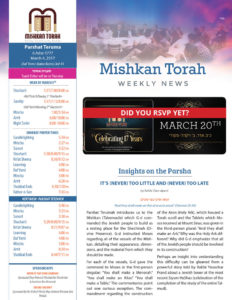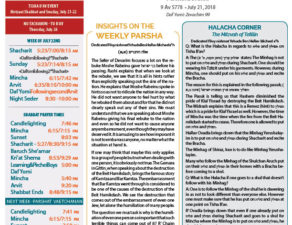
Insights on the Parsha
It’s (Never) Too Little and (Never) Too Late
by Rabbi Ozer Alport
ועשו ארון עצי שטים
“And they shall make an Ark of acacia wood.” (Shemot 25:10)
Parshat Terumah introduces us to the Mishkan (Tabernacle) which G-d commanded the Jewish people to build as a resting place for the Shechinah (Divine Presence). G-d instructed Moses regarding all of the vessels of the Mishkan, detailing their appearance, dimensions, and the material from which they should be made.
For each of the vessels, G-d gave the command to Moses in the first-person singular: “You shall make a Menorah.” “You shall make an Altar.” “You shall make a Table.” The commentaries point out one curious exception. The commandment regarding the construction of the Aron (Holy Ark), which housed a Torah scroll and the Tablets which Moses received at Mount Sinai, was given in the third-person plural: “And they shall make an Ark.” Why was the Holy Ark different? Why did G-d emphasize that all of the Jewish people should be involved in its construction?
Perhaps an insight into understanding this difficulty can be gleaned from a powerful story told by Rabbi Yissochar Frand about a Jewish boxer at the most recent Siyum HaShas (celebration of the completion of the study of the entire Talmud).
The boxer had a son, who grew up ignorant of Judaism. As the boxer’s son grew up, he became interested in learning more about his roots and began studying with great diligence in a local yeshiva. When he came home each night, he engrossed himself in the review of that day’s Talmudic studies. His father couldn’t fathom what could be so stimulating and enjoyable about the study of the Talmud. Eventually, the father begged his son to teach him, but the son dismissed him, explaining that he didn’t even know Hebrew and certainly couldn’t understand a page of difficult Aramaic text. The father pressed his son to at least give him a taste by teaching him just one daf (page) of Talmud. The son relented, but it was a long, arduous project. Line by line they continued, plodding forward until after one year they realized their goal and completed one full daf.
The father wanted to make a siyum to celebrate, but the son explained that one must complete an entire tractate to make a siyum. The father persisted with his request, and the son agreed to ask Rav Moshe Feinstein (1895-1986), the leading legal authority of the generation. Rabbi Feinstein ruled that under the circumstances it was permissible to make a siyum, and even insisted on attending.
The night after the siyum, the boxer died in his sleep. Eulogizing the man, Rabbi Feinstein commented that just as the Talmud states that some people acquire their portion in the World to Come through one deed, this man acquired it through one daf.
In light of this story, we can appreciate an answer to our question given by many commentators. The Aron, with the Torah scroll and Tablets inside, represents the study of Torah. Just as every Jew has his portion in Torah study, every Jew contributed to the building of the holy ark.
Every one of us has his own unique share in the Torah. It may be completing the entire Talmud, it may be finishing one daf, and it may be studying on the phone for one hour a week. The key is to remember Rabbi Frand’s message: “whatever we do, it’s never too little, it’s never too late, and it’s never enough.”










